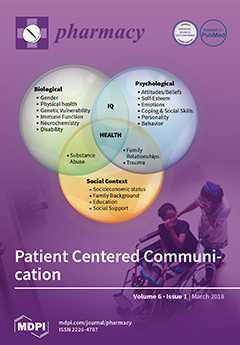Patients receiving clozapine must undergo routine blood monitoring to screen for neutropenia, and to monitor for potential agranulocytosis. In Cork University Hospital, Cork, Ireland, clozapine is dispensed in the hospital pharmacy and the pharmacists are not aware of co-prescribed medicines, potentially impacting upon
[...] Read more.
Patients receiving clozapine must undergo routine blood monitoring to screen for neutropenia, and to monitor for potential agranulocytosis. In Cork University Hospital, Cork, Ireland, clozapine is dispensed in the hospital pharmacy and the pharmacists are not aware of co-prescribed medicines, potentially impacting upon patient safety. The aim of this study was to examine the continuity of care of patients prescribed clozapine. A retrospective audit was conducted on patients attending the clozapine clinic at Cork University Hospital and assessed patients’ (i) independent living, (ii) co-prescribed medicines and (iii) knowledge of their community pharmacists regarding co-prescribed clozapine. A list of prescribed medicines for each patient was obtained, and potential drug-drug interactions between these medicines and clozapine were examined using Lexicomp
® and Stockley’s Interaction checker. Secondary outcomes included patients’ physical health characteristics, and a review of co-morbidities. Data were collected between the 29 May 2017 and 20 June 2017. Local ethics committee approval was granted. Patients were eligible for inclusion if they were receiving clozapine treatment as part of a registered programme, were aged 18 years or more, and had the capacity to provide written informed consent. Microsoft Excel was used for data analysis. Of 112 patients, (33% female; mean age (SD) 43.9 (11.3) years; 87.5% living independently/in the family home) 86.6% patients reported that they were taking other prescribed medicines from community pharmacies. The mean (SD) number of co-prescribed medicines in addition to clozapine was 4.8 (4) per patient. Two thirds of community pharmacists were unaware of co-prescribed clozapine. Interactions with clozapine were present in all but 3 patients on co-prescribed medicines (
n = 97). Lexicomp
® reported 2.9 drug-drug interactions/patient and Stockley’s Interaction Checker reported 2.5 drug-drug interactions/patient. Secondary outcomes for patients included BMI, total cholesterol, and HbA
1c levels, which were elevated in 75%, 54% and 17% respectively. Patients prescribed clozapine did not receive a seamless service, between primary and secondary care settings. Community pharmacists were not informed of clozapine, prescribed for their patients, in two thirds of cases. Patients in this study were exposed to clozapine-related drug-drug interactions and hence potential adverse effects. This study supports reports in the literature of substandard management of the physical health of this patient group. This study shows that there is an opportunity for pharmacists to develop active roles in the management of all clozapine-related effects, in addition to their traditional obligatory role in haematological monitoring. This study supports the need for a clinical pharmacist to review inpatients commencing on clozapine, monitor for drug-drug interactions and provide counselling.
Full article





